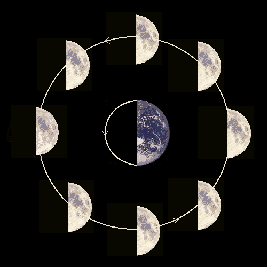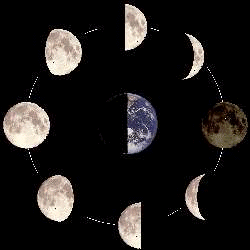
Looking down on the earth moon system
from the North Celestial pole. The sun is to
the right

The phases that we see from earth when the
moon is in the same positions as in the
diagram above. Again, the sun is to the right
|
Lunar rotation
The moon always turns the same face towards the earth. This is only possible
if the moon rotates once for every time it orbits the earth, one rotation
for every one revolution. This is called synchronous rotation.
Lunar revolution
Because the moon revolves around the earth, and its position relative the
earth and the sun changes every moment, we see different amounts
of the same face of the moon being lit from the earth, i.e., we
see the moon going through its phases.
It is important to realize that just like the Earth, half the moon is
lit at all times, and there is no dark side to the moon. (What we call
the dark side is really the side that is always facing away from us and
that we never see from the earth)
Phases of the moon
What we see from the earth as the moon revolves, is a varied amount
of the face that is always towards us being lit. When the moon is between
the earth and the sun, the lit side is facing away from us and we cannot
see the moon, it is a new moon. Progressively, as the moon revolves,
we see more and more of the face being lit, the moon is growing, waxing.
It waxes from a sliver, a crescent, through half the surface being
lit, a first quarter, to more than half the surface being lit, a
gibbous moon, till it is full. From the full moon, the lit
part decreases again, it wanes through a gibbous phase to
third (or last) quarter and a waning crescent to again disappear
as a new moon.
|





